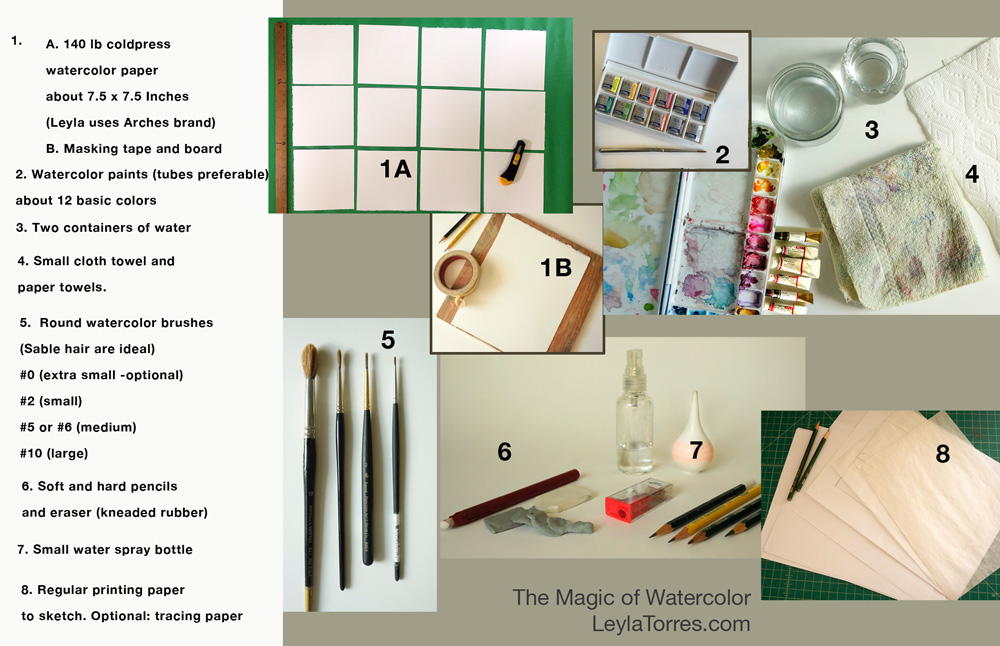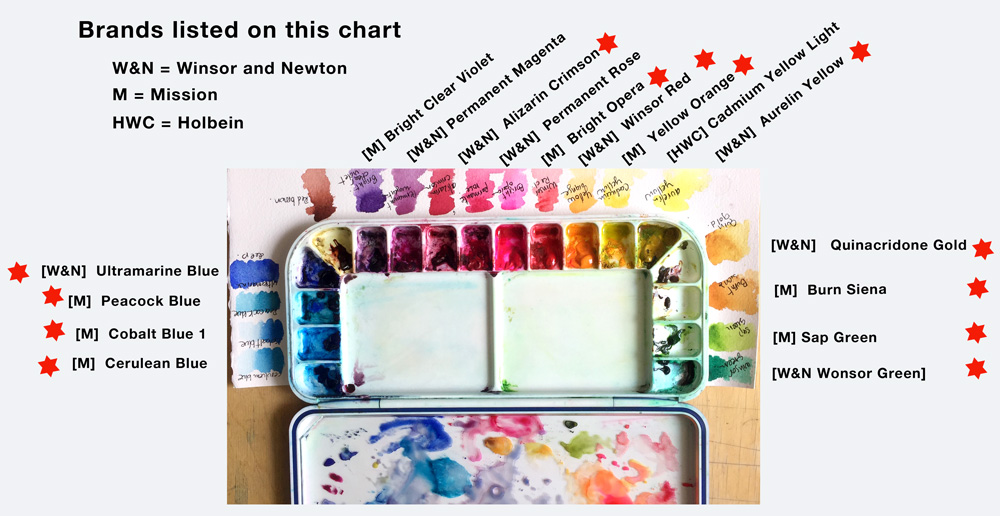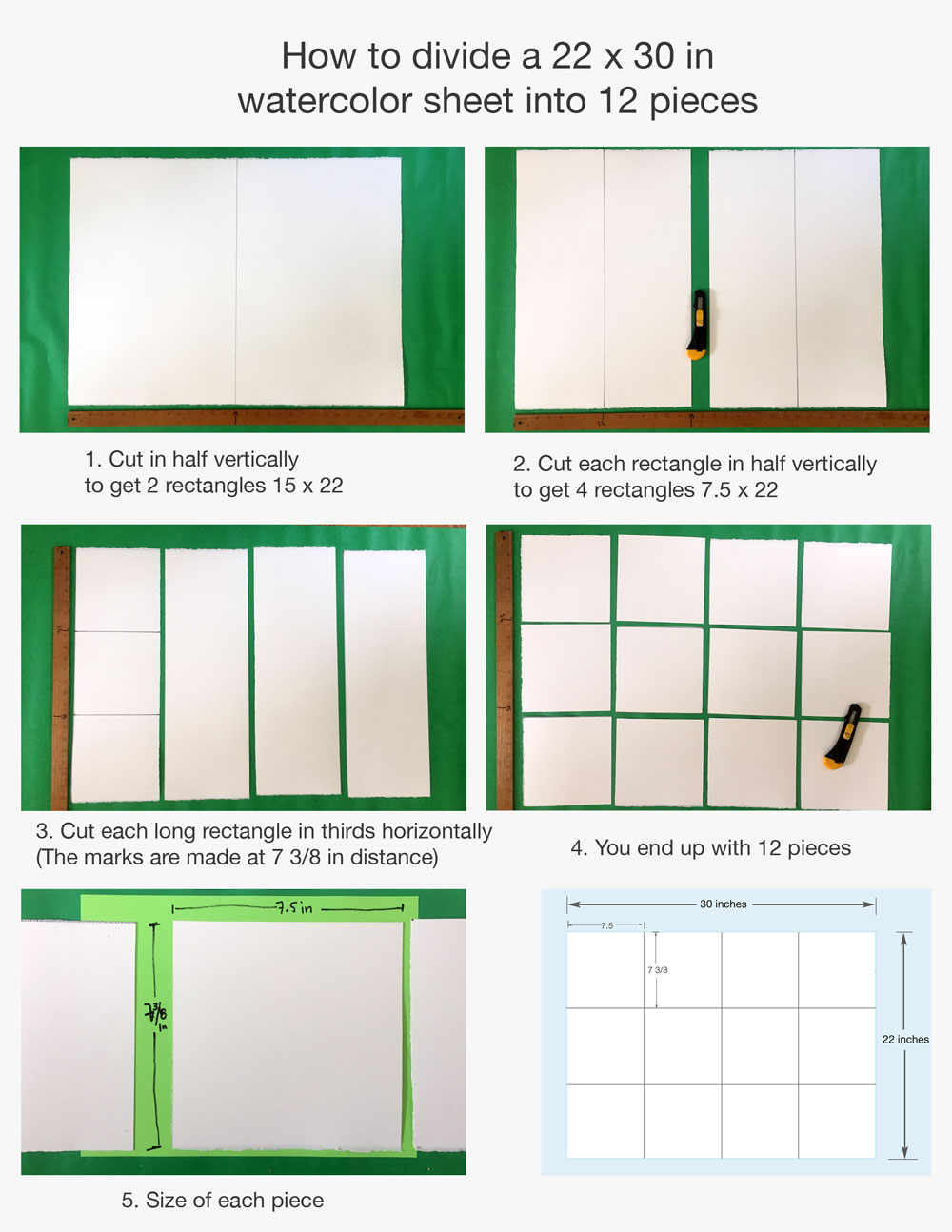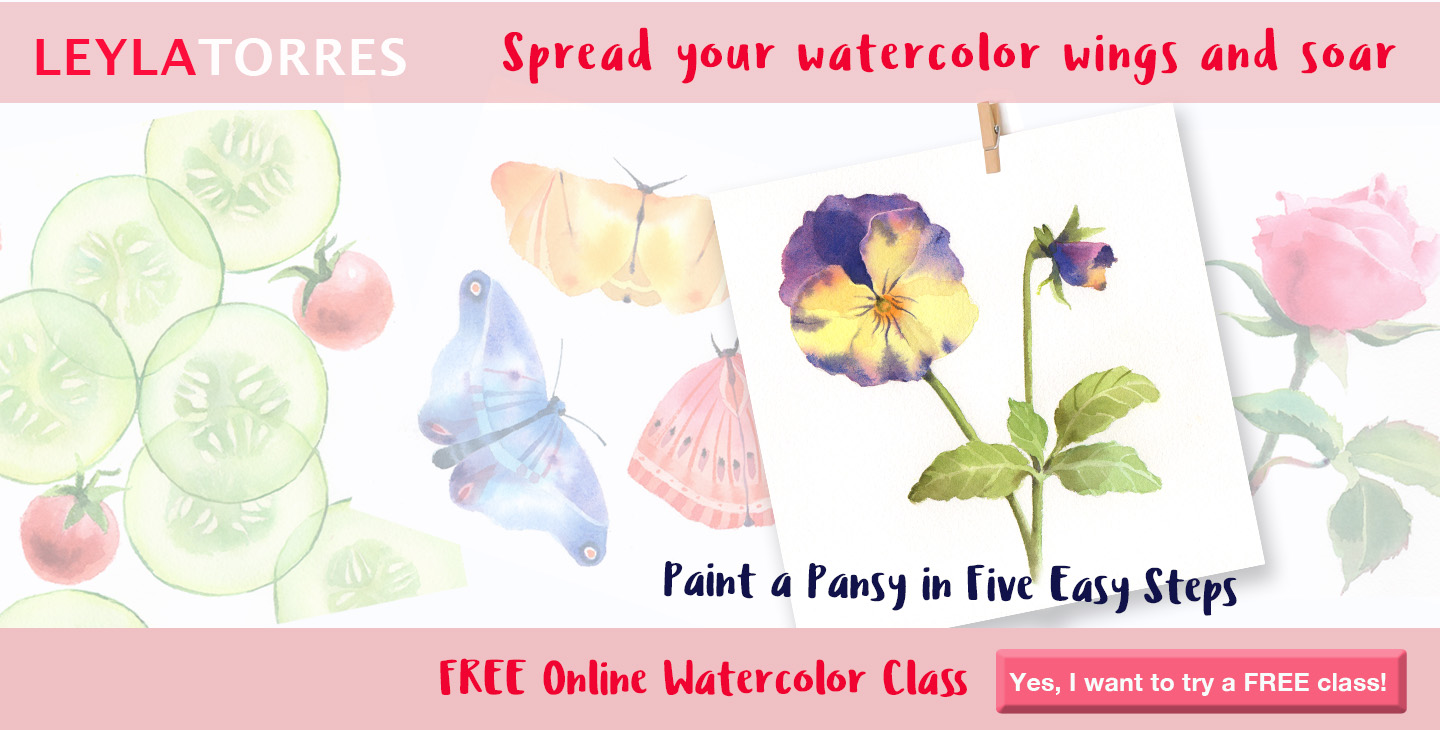This is a list of materials and paints suggested for The Magic of Watercolor course.
If you already have your own watercolor paints, preferred paper and brushes, you can use them as well.
If you need to buy materials, I recommend these ONLINE ART STORE IN THE USA:
Click here to download a printer-friendly pdf list

1. Watercolor paper, 140 lb, cold press, about 7.5 x 7.5 Inches (20 x 20 cm).
(Scroll all the way down for tips on how to cut a large piece of paper into smaller sheets.)
2. Watercolor paints -about 12 basic colors** (see suggested colors below)
3. Two containers of water
4. Small cloth towel and paper towels.
5. Round watercolor brushes: #0 (extra small -optional); #2 (small); #5 or #6 (medium); #10-12 (large)
6. Soft and hard pencils and eraser (kneaded rubber eraser, preferable)
7. Small water spray bottle
8. Two Plywood or plastic boards about 8.5 x 11 inches (Just larger than the sheet used for painting.)
9. Masking tape
. . . . . . . . . .
And here follows a more in-depth description
PAPER
Artist-grade watercolor paper is usually made with 100% rag fibers such cotton or linen.
It is acid free and comes in different sizes, weights, and textures.
For my course demonstrations, I use my preferred watercolor paper:
Arches 140lb, Cold Press
An economical way to prepare this paper is by buying 22 x 30 inch sheets pieces and cutting them to about 7.5 x 7.3 inch in size, which is the size used in my demonstrations.
WATERCOLOR PAINTS
In the following picture you see suggested paint colors.
You may use any watercolor brand and colors of your preference.

Ideally, you’ll use professional-grade watercolor paints and have one warm and one cool version of each color.
For example:
Sap green (warm) and Winsor Green (cool)
Winsor Red (warm) and Alizarin crimson (cool)
Peacock Blue (warm) Ultramarine Blue (Cool)
Your own palette will be a VERY personal collection of warm and cool pigments that reflect your taste.
List of color paints and brands in Leyla’s basic palette. The colors I consider indispensable for myself are in boldface (marked with a red star on the photo).
Brands mentioned: [W&N ]= Winsor and Newton [M ]= Mission [HWC] = Holbein
Cerulean Blue [M]
Cobalt Blue [M]
Peacock Blue [M]
Ultramarine Blue [W&N]
Red brown [M]
Bright Clear Violet [M]
Permanent Magenta [W&N]
Alizarin Crimson [W&N]
Permanent Rose [W&N]
Bright Opera [M]
Winsor Red [W&N]
Yellow Orange [M]
Cadmium Yellow Light [HWC]
Aurelin Yellow [W&N]
Quinacridone Gold [W&N]
Burn Siena [M]
Sap Green [M]
Windsor Green [W&N]
. . . . . . . .
PALETTES
Palettes come in different sizes. Any of the following options is fine.
• A pan set usually includes its own palette
• A portable palette with cover
• You can begin by using a large white ceramic plate
• The bigger your project the larger your palette should be.
• Individual containers come in handy for washes when preparing a larger amount of watercolor.
. . . . . . . .
BRUSHES
A good watercolor brush should be able to hold a sufficient quantity of watercolor, and be able to distribute watercolor smoothly and evenly. Good quality brush bristles will spring back to their original shape after each use.
Brushes are made from natural animal hair or from synthetic fibers. The best watercolor brushes are made from sable hair. If properly cared for these brushes will last many years. There are some excellent synthetic brushes available, too.
• Brush shape:
-Round brushes are the most versatile and widely used brush for watercolor painting.
-Flat brushes aren’t as versatile as round brushes, but they’re useful for washes.
• Brush size
If you’re buying watercolor brushes for the first time I recommend three round brushes: small (around size 2), medium (5-6), and large (10-12). These sizes are versatile and really the only brushes you need to get started.
As you gain experience you will want to acquire additional brushes of varying size and shape, depending on need.
Cleaning and storage
Rinse brushes with clean water after each session and store them, in a container, with the bristles facing up.
For traveling
I recommend a bamboo roll-up brush holder. To pack your brushes place your brush at one end, then roll; place another brush, roll; and so on until you’ve packed all your brushes.
WATER
Have at least two containers of water on hand.
One will hold clean clear water to use as needed; water in the second container is to rinse your brushes.
A Towel and paper towels to dry brushes
I usually keep a towel to my right on the work surface (I’m right handed)
and a paper towel at the base or edge of the painting closest to me.
Miscellaneous Materials
Printer paper and tracing paper For sketching and transferring
Pencils Have a range of soft and hard pencils HB (Normal), 2H 4H 2B 4B
ERASER To clean up excess pencil lines on watercolor paper use a soft eraser that won’t damage the paper’s fibers.
My favorite eraser for this is a Kneaded Rubber eraser. This eraser cleans pencil nicely, and leaves no residue. You can also use a Magic Rub by Sanford/PaperMate.
Not needed for the class, but just other options
• Opaque white pigment for highlights
• Masking fluid and Pik-Up Rubber Cement Eraser
• Natural sponges to dampen the paper or for special effects.

. . . . . . . . . . . . .
